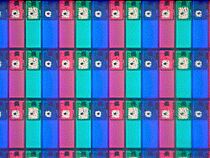Color TFT LCD
A color TFT LCD is a type of liquid crystal display that uses thin film transistors (TFTs) and color filters to give a full color image. It is the most useful kind of LCD. It can be found in laptop computers, smartphones, and TVs.
It is a low cost type of display. A more environmentally friendly design is to use LEDs directly as the illumination source.
It modulates the brightness of light from a backlight to make a grey scale image and uses red, green, and blue color filters to make a color image.[1]
A color TFT LCD is typically an active matrix TFT display. It is either TN or IPS.
Examples of gadgets that use LCDs are laptop computers and VR headsets like the Oculus Rift DK1 and Meta Quest 3.
Operating principle[edit]
An LCD is composed of a switching plane and a backlight. The switching plane has the functional pixels on it and is transparent when all the pixels are "on". There is also at least one polarizer layer.
The difference between TN and STN is that STN's angle of crystal rotation is higher.
Construction[edit]
An LCD is built from two glass substrates. The first is the switching substrate. The second is the color filter substrate. The substrates have liquid crystal in between them. The substrates are sealed together to keep the liquid crystal in.
The two substrates must be aligned. The subpixels of the color filter substrate must line up with the individual transistors on the transistor substrate.
The TFT layer is deposited on the switching substrate, also called the backplane. It can be done using amorphous silicon.
There may be a switching transistor and a driving transistor for each pixel. There is also a hold capacitor.[2]
Materials[edit]
An LCD involves a layer of anisotropic conductive film between the driver electronics and the display glass.
The display glass has the matrix of switching elements and their transistors, and typically ITO. The ACF connects to the ITO.
Indium tin oxide (ITO) is used.[3]
A liquid crystal mixture is used. Merck KGaA is a supplier of liquid crystal mixtures.[4]
Liquid crystals[edit]
There are a variety of liquid crystals that can be used.
Substrates[edit]
LCDs typically use glass as a substrate.
According to Schott as of 2008, most of the glass substrates that are built into TFT-LCDs are 0.7 mm thick.
Corning has produced glass substrates for LCDs.[6] An example is Corning EAGLE XG.
Schott is another company that has produced substrates and wafers.[7]
Manufacturing[edit]
- Main article: LCD manufacturing
Trivia[edit]
- LG display was a supplier to Apple of the late 2008 Macbook Pro TN displays.[8]
References[edit]
- ↑ "Details for IEV number 845-32-037: "LCD"" (in ja). https://www.electropedia.org/iev/iev.nsf/display?openform&ievref=845-32-037.
- ↑ https://swh.princeton.edu/~sturmlab/theses/BahmanThesis_part2.pdf
- ↑ "FPD Materials". https://abachy.com/catalog/flat-panel-display/fpd-materials.
- ↑ https://www.emdgroup.com/en/expertise/displays/solutions/liquid-crystals/lcd-technologies.html
- ↑ "2Compositional Analysis of Merck E7 Liquid Crystal Intermediates Using UltraPerformance Convergence Chromatography". https://www.waters.com/webassets/cms/library/docs/720004814en.pdf.
- ↑ "Thin-Film Transistor (TFT) Liquid Display Glass Substrate Technology". 2024-06-06. https://www.corning.com/worldwide/en/products/display-glass.html.
- ↑ "SCHOTT Substrates and Wafers". https://www.schott.com/en-us/products/substrates-and-wafers-p1000335.
- ↑ https://www.ifixit.com/Guide/MacBook+Pro+15-Inch+Unibody+Late+2008+and+Early+2009+LCD+Replacement/3561

